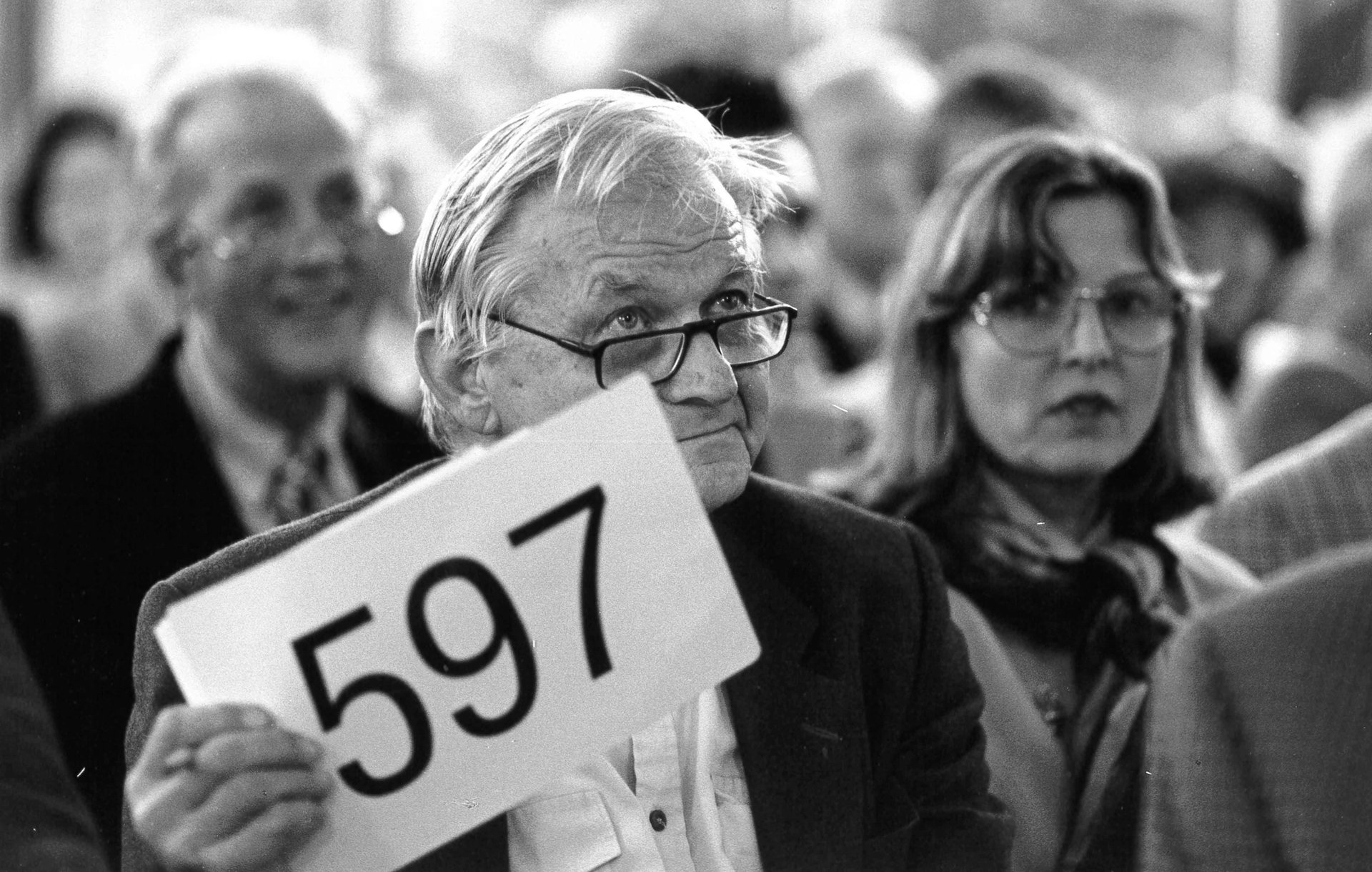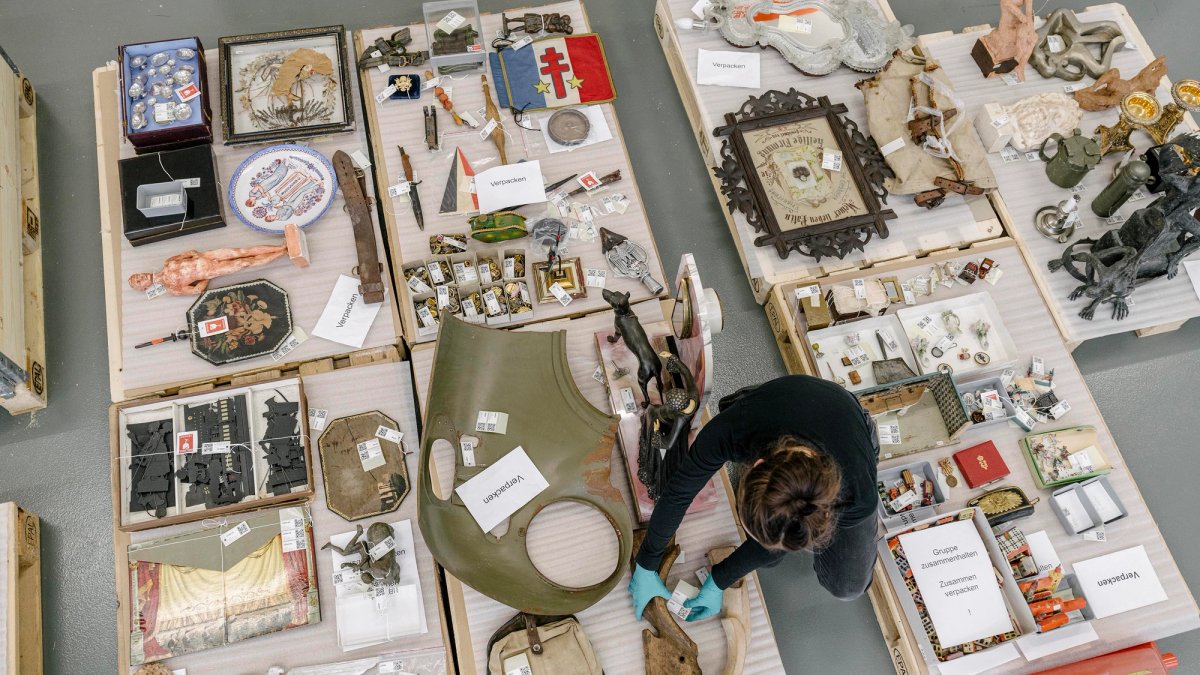Sifting through a lifetime’s worth of accumulated belongings is an often burdensome, sometimes painful experience to many who have suffered a bereavement. Few, though, are confronted with an estate like that of Bruno Stefanini, a Swiss real estate magnate and obsessive collector.
Stefanini hoarded art, buildings, eclectic historical memorabilia and weaponry (including live devices) as well as 30-year-old tuna cans and truckloads of old newspapers. He acquired more than 100,000 objects, but he did not take care of them. His collection was contaminated with mildew, woodworm, asbestos, mercury and radioactivity when he died in 2018 at the age of 94.
The task of cleaning and sorting this vast, messy trove fell to the Foundation for Art, Culture and History (SKKG), which he created in 1980 and is now led by his daughter, Bettina. Since 2018 the foundation, which is funded with income from the approximately 2,500 properties inherited from Bruno Stefanini, has cleaned and inventoried the collection. It is now digitised and, since March, searchable online.

Bruno Stefanini was a keen auction goer Edouard Rieben
Serendipitous browsing in the database turns up such oddities as Kaiser Wilhelm II’s
portable washroom, used for field trips during the First World War, complete with a zinc bidet and bathtub; the “smallest pocket-watch in the world”; a full-sized tank as well as several tank models; two of Charlie Chaplin’s walking sticks, several of his ties and even his pyjamas and braces.
He had to build a nest, and he went around collecting everything possible, like a birdVeronika Stefanini, Bruno’s ex-wife
“We have put almost our entire collection online—everything we possibly could, in a way that is of a very high standard in terms of open access,” says Reto Thüring, the foundation’s head of culture, and former chair of the department of contemporary art at the Museum of Fine Arts, Boston. “All our paintings are accessible, not just the front, but also the back. We have put information online, where we have it, such as the price Bruno Stefanini originally paid for it, where he bought it, and the provenance.”
Ongoing provenance research
The collection includes around 6,000 paintings, among them valuable works by Ferdinand Hodler, Cuno Amiet and Félix Vallotton. Provenance, like conservation, was not a priority for Stefanini. The foundation has hired a research team to investigate the ownership history of his art and appointed an independent panel to decide which works should be restituted to the heirs of Jewish collectors persecuted by the Nazis. The panel is at present evaluating three paintings with questionable origins, by Hodler, Giovanni Segantini and Arnold Böcklin.

Château de Grandson, one of four Swiss castles Stefanini owned, is set to open as a museum next year © Raphaël Dupertuis/Château de Grandson
While the SKKG has no plans for its own museum, it regularly lends to other institutions. Four works from the collection are on show during Art Basel at the Kulturstiftung Basel H. Geiger in an exhibition promoted as a rediscovery of the long overlooked Swiss artist Irène Zurkinden.
“Unlike the Hodler and Anker works, which are constantly being requested, these paintings, to my knowledge, have never been shown since they entered the foundation’s collection,” says Thüring, who is curating the exhibition with Rebecca Eigen. Zurkinden is one of several women artists whose work Stefanini bought, and who have since emerged from relative obscurity.
The foundation is also looking ahead. “We have now done a lot of the necessary work in terms of protecting the collection from being completely lost due to major damages and the hazardous conditions it was kept in, and we have done a lot of provenance research, which we are committed to continuing,” Thüring says. “Now we’re really setting our sights on the future; starting to think about what is the next chapter that we’re just beginning to write.”
One important project is the construction of Campo in Winterthur, on a site comprising offices and residential buildings bought by Stefanini in 2006. SKKG is investing SFr130m ($160m) to convert and extend the existing buildings into a complex comprising 70 homes, art and conservation studios, workshops, the foundation’s headquarters and an atrium for events, as well as a depot for the collection. Campo is scheduled to open in 2030.
Stefanini acquired four Swiss castles with the intention of showing his collection, though his ambitions were never realised. SKKG has sold two—Schloss Luxburg and Schloss Salenstein. Château de Grandson, near Yverdon-les-Bains on Lake Neuchâtel, is set to reopen next year after extensive restoration as a museum run by its own separate foundation. The fortress’s illustrious history dates back to 1094, but it is best known as the site of the 1476 Battle of Grandson, in which the Swiss defeated the mighty Burgundian army of Charles the Bold.
Crossbow collection
These armies used crossbows—the weapon also most associated with Switzerland’s national hero, William Tell, who, according to folklore, used one to shoot an apple off his son’s head. Stefanini owned hundreds of crossbows and the team responsible for Grandson plans to exhibit these there from 2027, along with a recently acquired UK collection of crossbows. Putting the two collections together results in “probably the most important crossbow collection in the world,” Thüring says.
The UK crossbow collection “was the only substantial accession we have made so far,” he says. “There will have to be a very specific case to be made for us to acquire anything more—we have a lot to care for already. But in this case it made sense because the [crossbow] collection came available and it was more global in scope.”
The second of Stefanini’s castles still in his foundation’s ownership presents a more complex challenge. He bought the baroque Schloss Brestenberg, once an elegant hotel in the canton of Aargau, west of Zurich, in 1984. His intention was to build an underground depot and museum for his collection. He built subterranean bunker-style walls but never achieved his vision in the cavernous space he created: he was forced to stop construction in 1993 in a conflict with the cantonal government. He never renovated the castle itself: it has lain dormant for more than four decades and is in a state of decay.
Thüring says SKKG is “very actively thinking about what it might become in the future”. The foundation is working with the local community to develop a concept; changing its use from hospitality would require a local referendum.
Telling Stefanini’s story is also an important part of the foundation’s work. A documentary about his life, Bruno Stefanini’s Legacy, was recently broadcast on Swiss television. It includes interviews with his family, former colleagues and with his fellow collector Christoph Blocher, a key figure in the right-wing Swiss People’s Party.
Stefanini’s collecting began in childhood. Veronika Stefanini, his wife from whom he had separated, attributes his obsession to a lack of security: his parents ran a restaurant and did not have much time for their sons. “It’s a syndrome connected to neglect,” she says in the film. “He had to build a nest, and he went around collecting everything possible, like a bird.”
Among the mountains of clutter SKKG employees found scattered around Stefanini’s properties were objects still in the packaging of the auction houses which had shipped them to him. Some items were so decayed they had to be thrown away. Unexploded live ammunition was handed over to the Swiss army, which detonated it in an Alpine valley.
Blocher recalls Stefanini once showing him his collection of rusting Russian tanks. “It was a mania he had,” he says. “‘I want that! I want that!’ [he said].”
The two collectors shared a passion for the work of the Swiss artist Albert Anker. They often competed at auctions, and Blocher recalls them both wanting to bid for an important Anker drawing. On this occasion, they agreed to share the drawing. Having each acquired 50%, Blocher says, he asked Stefanini who should keep it.
“Why don’t you have it,” Stefanini said. “I’ll never be able to find it again if I take it.”
• Irène Zurkinden: Love, Life, Kulturstiftung Basel H. Geiger, until 7 September




